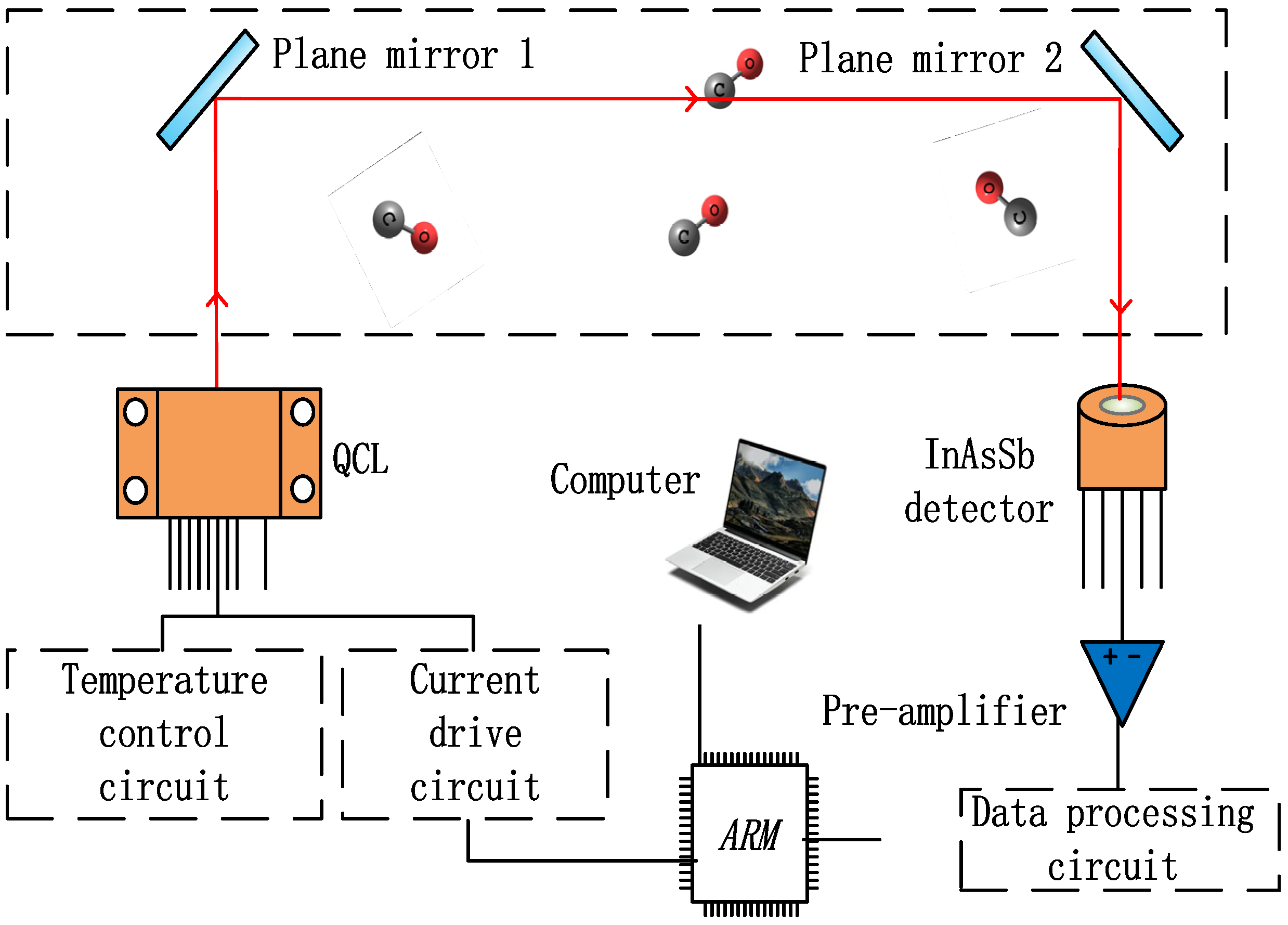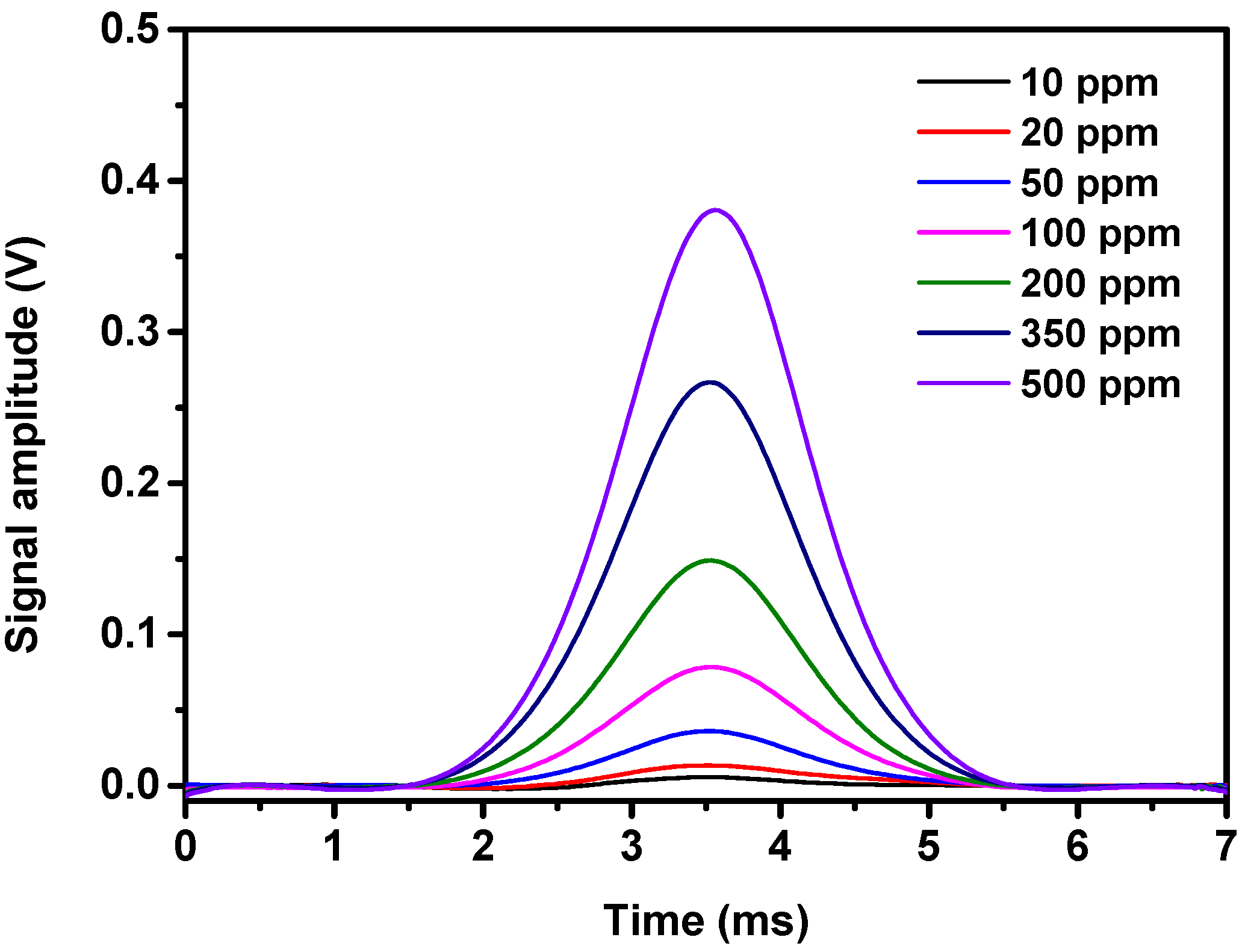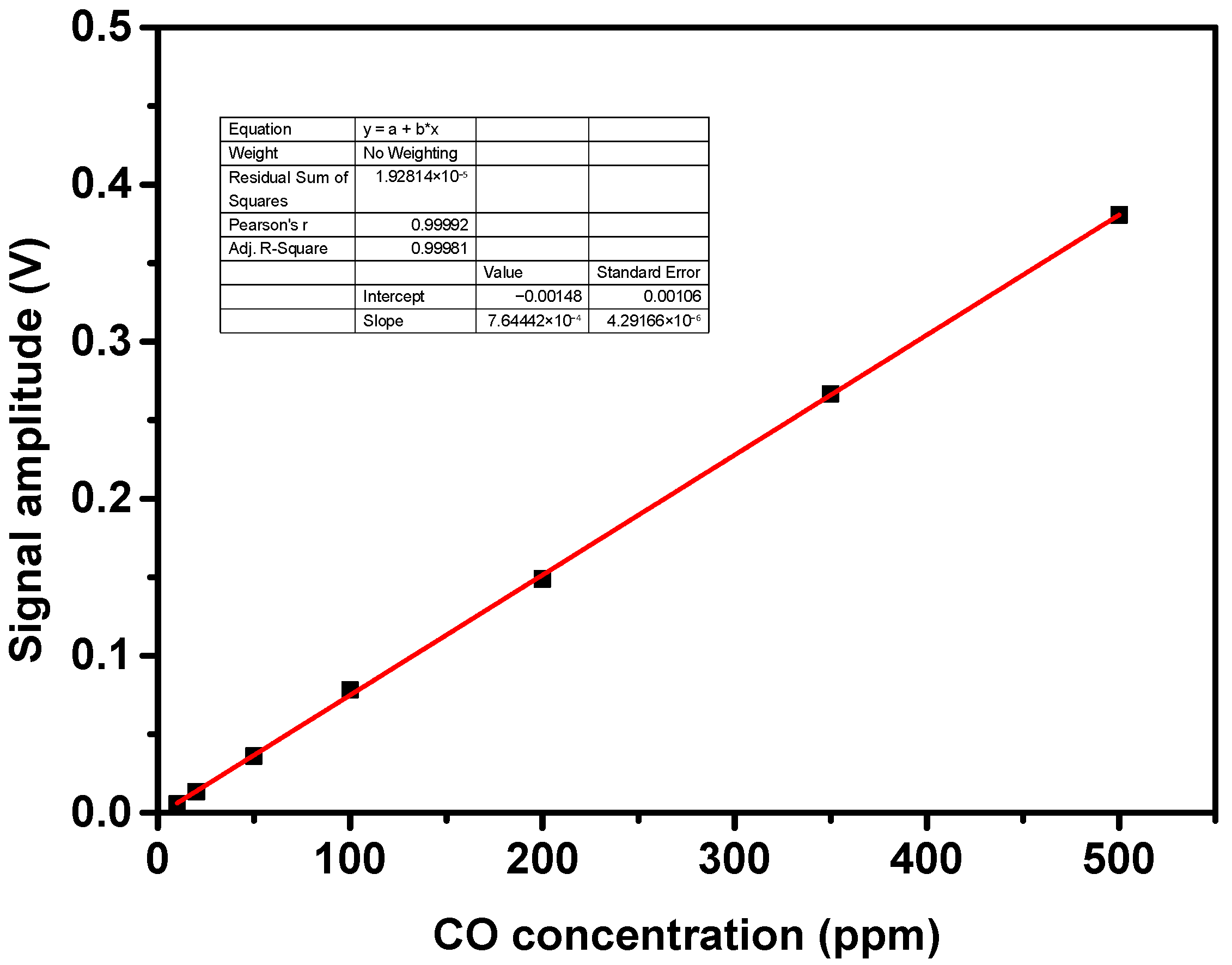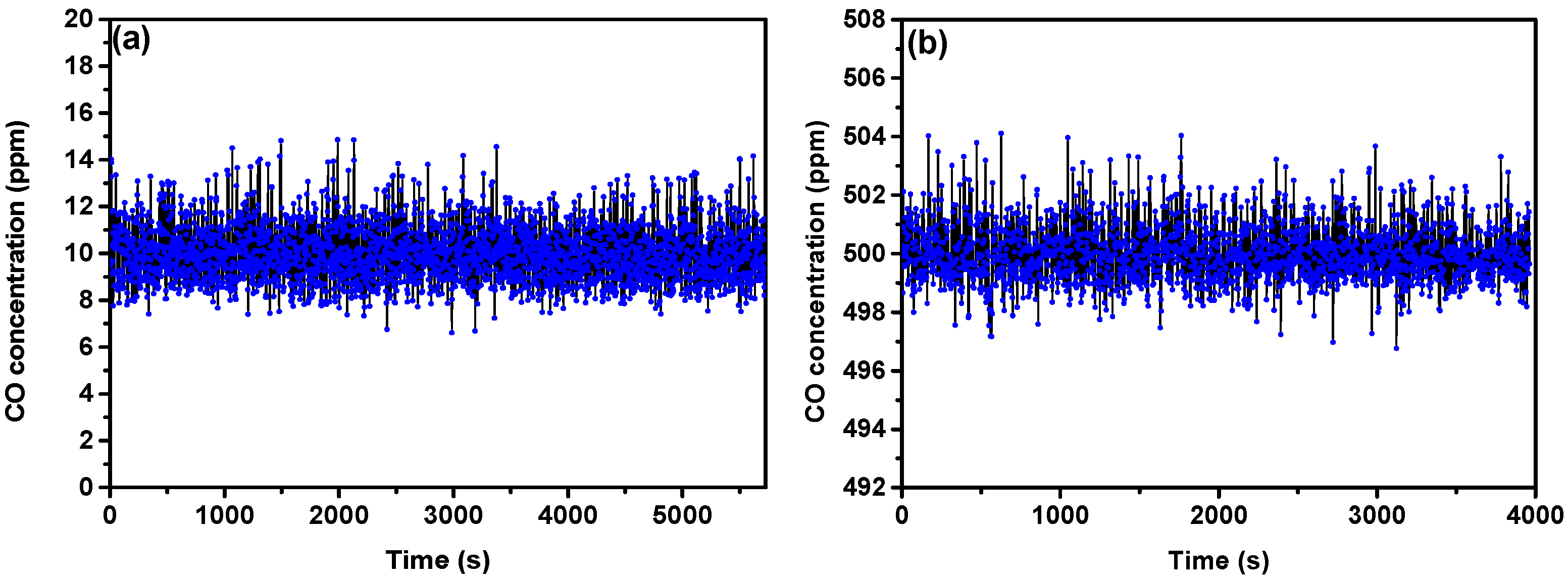Compact and Low-Power-Consumption CO Sensor Using a QCL with Intermittent Scanning Technique
Abstract
1. Introduction
2. Selection of CO Absorption Lines
3. Experimental Configuration
4. Intermittent Scanning Technique
5. Experimental Results
6. Discussion
7. Conclusions
Author Contributions
Funding
Institutional Review Board Statement
Informed Consent Statement
Data Availability Statement
Conflicts of Interest
References
- Wang, Z.; Li, Y.; Zhang, T.; Hu, J.; Wang, Y.; Wei, Y.; Liu, T.; Sun, T.; Grattan, K.T.V. A Sensitive and Reliable Carbon Monoxide Monitor for Safety-Focused Applications in Coal Mine Using a 2.33-μm Laser Diode. IEEE Sens. J. 2019, 20, 171–177. [Google Scholar] [CrossRef]
- Yamazoe, N.; Miura, N. Development of gas sensors for environmental protection. IEEE Trans. Compon. Packag. Manuf. Technol. A 1995, 18, 252–256. [Google Scholar] [CrossRef]
- Chen, C.-C.; Sung, G.-N.; Chen, W.-C.; Kuo, C.-T.; Chue, J.-J.; Wu, C.-M.; Huang, C.-M. A wireless and batteryless intelligent carbon monoxide sensor. Sensors 2016, 16, 1568. [Google Scholar] [CrossRef] [PubMed]
- Lewen, Z.; Zhirong, Z.; Qianjin, W.; Pengshuai, S.; Bian, W.; Tao, P.; Hua, X.; Sigrist, M.W. A sensitive carbon monoxide sensor for industrial process control based on laser absorption spectroscopy with a 2.3 μm distributed feedback laser. Opt. Lasers Eng. 2022, 152, 106950. [Google Scholar] [CrossRef]
- Zhang, T.; Wei, Y.; Li, Y.; Zhao, Y.; Liu, T.; Wang, C. High-resolution fiber carbon monoxide sensing system and its data processing. In Proceedings of the Fourth Asia Pacific Optical Sensors Conference, Wuhan, China, 15–18 October 2013; pp. 82–85. [Google Scholar]
- Yin, X.; Wu, H.; Dong, L.; Ma, W.; Zhang, L.; Yin, W.; Xiao, L.; Jia, S.; Tittel, F.K. Ppb-level photoacoustic sensor system for saturation-free CO detection of SF6 decomposition by use of a 10 W fiber-amplified near-infrared diode laser. Sens. Actuator B-Chem. 2019, 282, 567–573. [Google Scholar] [CrossRef]
- Qiao, S.; Ma, Y.; He, Y.; Yu, X.; Zhang, Z.; Tittel, F.K. A sensitive carbon monoxide sensor based on photoacoustic spectroscopy with a 2.3 μm mid-infrared high-power laser and enhanced gas absorption. Sensors 2019, 19, 3202. [Google Scholar] [CrossRef] [PubMed]
- He, Y.; Ma, Y.; Tong, Y.; Yu, X.; Tittel, F.K. A portable gas sensor for sensitive CO detection based on quartz-enhanced photoacoustic spectroscopy. Opt. Laser Technol. 2019, 115, 129–133. [Google Scholar] [CrossRef]
- Mondelain, D.; Sala, T.; Kassi, S.; Romanini, D.; Marangoni, M.; Campargue, A. Broadband and highly sensitive comb-assisted cavity ring down spectroscopy of CO near 1.57 µm with sub-MHz frequency accuracy. J. Quant. Spectrosc. Radiat. Transf. 2015, 154, 35–43. [Google Scholar] [CrossRef]
- Chen, H.; Karion, A.; Rella, C.; Winderlich, J.; Gerbig, C.; Filges, A.; Newberger, T.; Sweeney, C.; Tans, P.P. Accurate measurements of carbon monoxide in humid air using the cavity ring-down spectroscopy (CRDS) technique. Atmos. Meas. Tech. 2013, 6, 1031–1040. [Google Scholar] [CrossRef]
- Sun, K.; Wang, S.; Sur, R.; Chao, X.; Jeffries, J.B.; Hanson, R.K. Time-resolved in situ detection of CO in a shock tube using cavity-enhanced absorption spectroscopy with a quantum-cascade laser near 4.6 µm. Opt. Express 2014, 22, 24559–24565. [Google Scholar] [CrossRef] [PubMed]
- Provencal, R.; Gupta, M.; Owano, T.G.; Baer, D.S.; Ricci, K.N.; O’Keefe, A.; Podolske, J.R. Cavity-enhanced quantum-cascade laser-based instrument for carbon monoxide measurements. Appl. Opt. 2005, 44, 6712–6717. [Google Scholar] [CrossRef] [PubMed]
- Wang, F.; Li, N.; Huang, Q.; Yan, J.; Cen, K. Measurements on CO concentration and gas temperature at 1.58 μm with tunable diode laser absorption spectroscopy. In Proceedings of the AIP Conference Proceedings, Macao, China, 1–2 February 2013; pp. 499–508. [Google Scholar]
- Sane, A.; Satija, A.; Lucht, R.P.; Gore, J.P. Simultaneous CO concentration and temperature measurements using tunable diode laser absorption spectroscopy near 2.3 μm. Appl. Phys. B-Lasers Opt. 2014, 117, 7–18. [Google Scholar] [CrossRef]
- Teichert, H.; Fernholz, T.; Ebert, V. Simultaneous in situ measurement of CO, H2O, and gas temperatures in a full-sized coal-fired power plant by near-infrared diode lasers. Appl. Opt. 2003, 42, 2043–2051. [Google Scholar] [CrossRef] [PubMed]
- Cui, R.; Dong, L.; Wu, H.; Li, S.; Zhang, L.; Ma, W.; Yin, W.; Xiao, L.; Jia, S.; Tittel, F.K. Highly sensitive and selective CO sensor using a 2.33 μm diode laser and wavelength modulation spectroscopy. Opt. Express 2018, 26, 24318–24328. [Google Scholar] [CrossRef]
- Shao, L.; Fang, B.; Zheng, F.; Li, S.; Zhang, L.; Ma, W.; Yin, W.; Xiao, L.; Jia, S.; Tittel, F.K. Simultaneous detection of atmospheric CO and CH4 based on TDLAS using a single 2.3 μm DFB laser. Spectrochim. Acta A 2019, 222, 117118. [Google Scholar] [CrossRef]
- Li, C.; Wu, Y.; Qiu, X.; Wei, J.; Deng, L. Pressure-dependent detection of carbon monoxide employing wavelength modulation spectroscopy using a herriott-type cell. Appl. Spectrosc. 2017, 71, 809–816. [Google Scholar] [CrossRef] [PubMed]
- Ye, W.; Li, C.; Zheng, C.; Sanchez, N.P.; Gluszek, A.K.; Hudzikowski, A.J.; Dong, L.; Griffin, R.J.; Tittel, F.K. Mid-infrared dual-gas sensor for simultaneous detection of methane and ethane using a single continuous-wave interband cascade laser. Opt. Express 2016, 24, 16973–16985. [Google Scholar] [CrossRef] [PubMed]
- Ghorbani, R.; Schmidt, F.M. ICL-based TDLAS sensor for real-time breath gas analysis of carbon monoxide isotopes. Opt. Express 2017, 25, 12743–12752. [Google Scholar] [CrossRef] [PubMed]
- Dang, J.; Yu, H.; Sun, Y.; Wang, Y. A CO trace gas detection system based on continuous wave DFB-QCL. Infrared Phys. Technol. 2017, 82, 183–191. [Google Scholar] [CrossRef]
- Starecki, F.; Charpentier, F.; Doualan, J.; Quetel, L.; Michel, K.; Chahal, R.; Troles, J.; Bureau, B.; Braud, A.; Camy, P.; et al. Mid-IR optical sensor for CO2 detection based on fluorescence absorbance of Dy3+: Ga5Ge20Sb10S65 fibers. Sens. Actuator B-Chem. 2015, 207, 518–525. [Google Scholar] [CrossRef]
- Starecki, F.; Morais, S.; Chahal, R.; Boussard-Plédel, C.; Bureau, B.; Palencia, F.; Lecoutre, C.; Garrabos, Y.; Marre, S.; Nazabal, V. IR emitting Dy3+ doped chalcogenide fibers for in situ CO2 monitoring in high pressure microsystems. Int. J. Greenh. Gas Con. 2016, 55, 36–41. [Google Scholar] [CrossRef]
- Wei, T.; Wu, H.; Dong, L.; Cui, R.; Jia, S. Palm-sized methane TDLAS sensor based on a mini-multi-pass cell and a quartz tuning fork as a thermal detector. Opt. Express 2021, 29, 12357–12364. [Google Scholar] [CrossRef] [PubMed]
- Li, N.; Qiu, X.; Wei, Y.; Zhang, E.; Wang, J.; Li, C.; Peng, Y.; Wei, J.; Meng, H.; Wang, G.; et al. A portable low-power integrated current and temperature laser controller for high-sensitivity gas sensor applications. Rev. Sci. Initrum. 2018, 89, 103103. [Google Scholar] [CrossRef] [PubMed]
- Dong, L.; Tittel, F.K.; Li, C.; Sanchez, N.P.; Wu, H.; Zheng, C.; Yu, Y.; Sampaolo, A.; Griffin, R.J. Compact TDLAS based sensor design using interband cascade lasers for mid-IR trace gas sensing. Opt. Express 2016, 24, A528–A535. [Google Scholar] [CrossRef] [PubMed]
- Dong, L.; Li, C.; Sanchez, N.P.; Gluszek, A.K.; Griffin, R.J.; Tittel, F.K. Compact CH4 sensor system based on a continuous-wave, low power consumption, room temperature interband cascade laser. Appl. Phys. Lett. 2016, 108, 011106. [Google Scholar] [CrossRef]
- Gordon, I.; Rothman, L.; Hargreaves, R.; Hashemi, R.; Karlovets, E.; Skinner, F.; Conway, E.; Hill, C.; Kochanov, R.; Tan, Y.; et al. The HITRAN2020 molecular spectroscopic database. J. Quant. Spectrosc. Radiat. Transf. 2022, 277, 107949. [Google Scholar] [CrossRef]
- Li, L.; Cao, F.; Wang, Y.; Cong, M.; An, Y.; Song, Z.; Guo, S.; Liu, F.; Wang, L. Design and characteristics of quantum cascade laser-based CO detection system. Sens. Actuator B-Chem. 2009, 142, 33–38. [Google Scholar] [CrossRef]
- Hancock, G.; Van Helden, J.; Peverall, R.; Ritchie, G.A.D.; Walker, R.J. Direct and wavelength modulation spectroscopy using a cw external cavity quantum cascade laser. Appl. Phys. Lett. 2009, 94, 201110. [Google Scholar] [CrossRef]
- Qiao, S.; Ma, Y.; He, Y.; Patimisco, P.; Sampaolo, A.; Spagnolo, V. Ppt level carbon monoxide detection based on light-induced thermoelastic spectroscopy exploring custom quartz tuning forks and a mid-infrared QCL. Opt. Express 2021, 29, 25100–25108. [Google Scholar] [CrossRef]
- Vanderover, J.; Wang, W.; Oehlschlaeger, M. A carbon monoxide and thermometry sensor based on mid-IR quantum-cascade laser wavelength-modulation absorption spectroscopy. Appl. Phys. B-Lasers Opt. 2011, 103, 959–966. [Google Scholar] [CrossRef]
- Li, J.; Deng, H.; Sun, J.; Yu, B.; Fischer, H. Simultaneous atmospheric CO, N2O and H2O detection using a single quantum cascade laser sensor based on dual-spectroscopy techniques. Sens. Actuator B-Chem. 2016, 231, 723–732. [Google Scholar] [CrossRef]
- Werle, P.O.; Mücke, R.; Slemr, F. The limits of signal averaging in atmospheric trace-gas monitoring by tunable diode-laser absorption spectroscopy (TDLAS). Appl. Phys. B-Lasers Opt. 1993, 57, 131–139. [Google Scholar] [CrossRef]
- Li, J.; Parchatka, U.; Fischer, H. Development of field-deployable QCL sensor for simultaneous detection of ambient N2O and CO. Sens. Actuator B-Chem. 2013, 182, 659–667. [Google Scholar] [CrossRef]
- Tao, L.; Sun, K.; Khan, M.A.; Miller, D.J.; Zondlo, M.A. Compact and portable open-path sensor for simultaneous measurements of atmospheric N2O and CO using a quantum cascade laser. Opt. Express 2012, 20, 28106–28118. [Google Scholar] [CrossRef] [PubMed]








Disclaimer/Publisher’s Note: The statements, opinions and data contained in all publications are solely those of the individual author(s) and contributor(s) and not of MDPI and/or the editor(s). MDPI and/or the editor(s) disclaim responsibility for any injury to people or property resulting from any ideas, methods, instructions or products referred to in the content. |
© 2023 by the authors. Licensee MDPI, Basel, Switzerland. This article is an open access article distributed under the terms and conditions of the Creative Commons Attribution (CC BY) license (https://creativecommons.org/licenses/by/4.0/).
Share and Cite
Zhang, Q.; Hu, J.; Wei, Y.; Li, B.; Liu, G.; Zhang, T.; Wang, Z.; Gong, W.; Liu, T. Compact and Low-Power-Consumption CO Sensor Using a QCL with Intermittent Scanning Technique. Photonics 2023, 10, 95. https://doi.org/10.3390/photonics10010095
Zhang Q, Hu J, Wei Y, Li B, Liu G, Zhang T, Wang Z, Gong W, Liu T. Compact and Low-Power-Consumption CO Sensor Using a QCL with Intermittent Scanning Technique. Photonics. 2023; 10(1):95. https://doi.org/10.3390/photonics10010095
Chicago/Turabian StyleZhang, Qinduan, Jie Hu, Yubin Wei, Binkai Li, Guancheng Liu, Tingting Zhang, Zhaowei Wang, Weihua Gong, and Tongyu Liu. 2023. "Compact and Low-Power-Consumption CO Sensor Using a QCL with Intermittent Scanning Technique" Photonics 10, no. 1: 95. https://doi.org/10.3390/photonics10010095
APA StyleZhang, Q., Hu, J., Wei, Y., Li, B., Liu, G., Zhang, T., Wang, Z., Gong, W., & Liu, T. (2023). Compact and Low-Power-Consumption CO Sensor Using a QCL with Intermittent Scanning Technique. Photonics, 10(1), 95. https://doi.org/10.3390/photonics10010095





